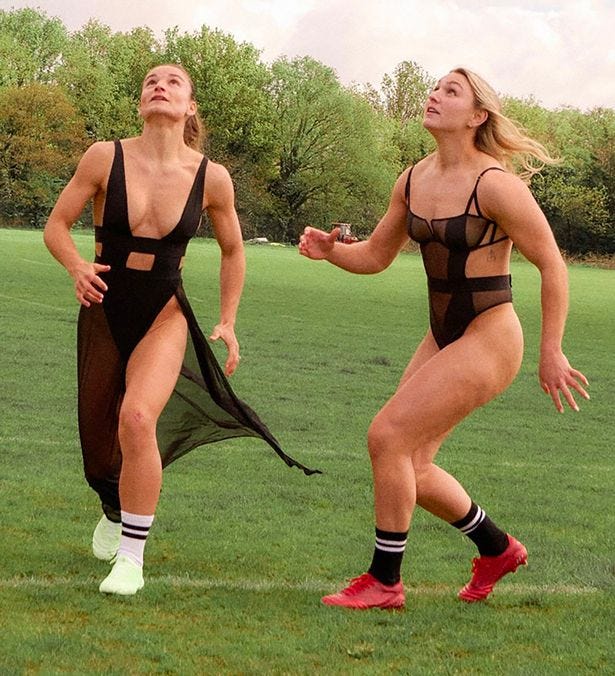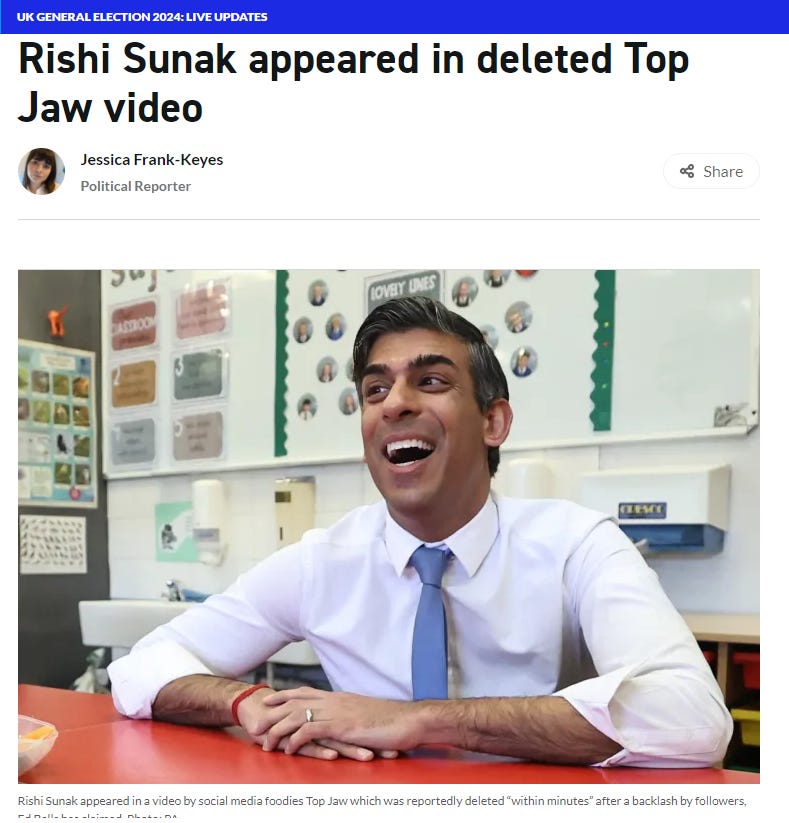Borkowksi Media Trends: Rugby Takes its Kit Off, TikTok is the Real Election Winner & MORE
PLUS: Labour Takes Over the Right Wing Press | Wokeism at Glastonbury?
GB Rugby Team Strips Back to Basics
Sex sells. We’ve all heard this before and no doubt seen copious examples of it being used to gain attention *Challengers film trailer we’re looking at you*. There is a careful balancing act to be conducted between producing an advert which is empowering in its sexuality, and one which exploits its subject for the sake of publicity. Get this wrong and you could find yourself in the middle of an unwanted debate.
Bluebella’s recent partnership with the GB Olympic rugby team to launch the latest version of their #StrongIsBeautiful campaign found itself in the middle of a media storm when it published a series of images of the GB rugby team in lingerie. The campaign aims to help improve teenage girls’ confidence when it comes to participating in sport and encourages body positivity. The photographs include a range of images of Ellie Boatman, Celia Quansah and Jasmine Joyce in lingerie and rugby boots performing a series of rugby moves or standing with a rugby ball looking at the camera. The poses the women are in are not those conventionally associated with ‘sexy’ photoshoots.
Despite this, the campaign has elicited an outcry in the media, with articles in the Telegraph, Independent and Sun to name but a few, asking ‘Is this the most offensive lingerie ad ever?’ and calling the campaign ‘sexist’. Criticism also came from 3 former Olympians quoted in the Sun, with Sharron Davies (silver medallist in the 400m medley in 1980) slamming the campaign as regressive for featuring women in ‘porn underwear’. Distance runner Mara Yamauchi also called it exploitative and claimed the campaign objectifies women. Their criticism sits in sharp contrast to Women’s Health’s take on the campaign which calls it empowering.
Rugby PR has traditionally been associated with middle class men, so it is no surprise that first impressions of this campaign were received with scepticism. Most social media criticism circles back to references of 90s adverts featuring scantily clad women which were predominantly designed by men, for men. This campaign, however, is not that. As highlighted by Women’s Health who interviewed the three featured athletes, they felt that the opportunity to wear feminine clothes and break away from the masculine stereotypes associated with rugby was empowering. The images themselves are powerful, with the women playing rugby or standing tall, shot for the female gaze in consultation with the women modelling.
The campaign is brave in its boldness, seeking to reclaim lingerie for female empowerment, the backlash (especially from middle aged and older women) is a testament to the many years in which they endured ad campaigns designed for the male gaze. Time will tell as to whether it has resonated with its target audience, teenage women.
Is Social Media the New Vote Winner?
The general election has happened, and the results are in. After 14 gruelling years, austerity, a global pandemic, and the price of a Freddo rocketing up to an eyewatering 25p, the Labour party has finally won. Labour’s election win comes as no surprise, what’s more interesting has been the percentage of votes won by smaller parties. In Britain’s first past the post system, there can be large discrepancies between the number of votes one and the number of seats won, with the number of seats not always reflective of the vote quantity. In terms of sheer number of votes, the smaller parties won approximately 40%. For comparison, Labour won 34% of the vote but 63% of seats, the Lib Dems won 3.49m votes and 71 seats, the Greens 1.9m votes and 4 seats and Reform snatched 4m votes and 4 seats. The complexities and parity of the UK political system is a debate for another day; however, the raw voter numbers show a clear swing away from the dominant parties and towards smaller, newer options. The success of these smaller parties could be argued due to the growing popularity of using social channels to drive votes and reach audiences overlooked by conventional campaigning.
In today's media landscape social media is one of the main forms of sharing and consuming information. In the Reuters Digital News Report, TikTok is identified as being one of the biggest social media platforms that the public use to access news. 23% of under 25s reported using TikTok as a news source (click for a summary of the Reuter's Digital News Report). Thus, party leaders are increasingly leveraging platforms like Twitter, Facebook, and Instagram to reach a wider audience, bypassing traditional media channels and engaging new demographics.
Jeremy Corbyn has been one such example, effectively using social media to generate more votes. He has successfully won as an independent candidate in North Islington after his expulsion from the Labour party. With just under 700K followers on Instagram, Corbyn has quite the social media reach, on par with full time influencers. He has become a content creator in sharing his political views on this medium, using socials to present himself in an authentic way. Distancing from traditional media channels which can be viewed as overly polished or curated, Corbyn has leaned into his 'man of the people’ persona by speaking directly to his audience.
Another way influencers are being used to drive votes in General Elections is by motivating young people to vote in a certain way. In the US, there are designated content creators paid for by the political party, to promote their messaging. In the UK however content creators haven’t resorted to paying the influencers yet, rather politicians have become the source of content. Reform UK has been particularly successful in engaging younger audiences on TikTok, a demographic not traditionally linked to far-right politics, but very active on the social media platform. In the UK the Advertising Standards Authority (ASA) requires social media promotions to be labelled as adverts, which could make sponsored posts appear forced, deviating from the ‘authenticity’ of the medium.
Using influencers to drive votes can backfire; for example, the famous Rishi Sunak x Top Jaw video which was swiftly taken down immediately after getting released. As the results of the General Election has shown, the “using influencer marketing” strategy did not turn out well for Sunak. City AM has commented on the video by asking whether Sunak was trying too hard to appeal to young voters. Once again, we can see that authenticity is key in successfully leveraging socials to grow your support and reach new audiences. It will be interesting to see what happens in 2029.
Labour Dominates the Polls and the Press
Ahh the general election, we’ve been waiting for it, we’ve been following it, and now we’ve finally survived it. Britain is back in the red for the first time 14 years. It has been a short but intense 6-week campaign, with neither major party player being particularly impressive in anything other than intense mediocrity.
From Sunak’s gaff ridden ‘things can only get wetter’ launch, which in hindsight may have been the most optimistic moment of his campaign, to Starmer’s uninspiring debates and Davey’s summer of fun, these past 6 weeks have not produced much in the ways of inspiring PR. One thing Labour’s campaign director Morgan McSweeney did get right however, was the early purchase of all the advertising space available in right wing media. And it seems it was all available. From the Sun to the Metro, the Daily Star to Mail Online, all landing pages were emblazoned with Labour’s trademark red.
It appears that whilst the Tories were busy betting on prospective election dates, McSweeney was carefully scanning the betting odds and scrutinising activity at Westminster. Smelling a drowning rat about to leap overboard, he suspected an election to be immanent and sought out advertising space in the papers most likely to reach non traditionally Labour leaning voters. In their internal confusion and chaos, the Tories had apparently purchased none of the ad space, leaving Labour to dominate. Winning the election involved targeting people who had voted Conservative in the last election, and this meant leaving the echo chamber of papers who declared for Labour and fighting a way into new territory. Buying up advertising space is a smart and arguably easier way than seeking newspaper endorsement.
Anyone who visited any of these right leaning newspapers on election day would have been met with a sea of red. Well played McSweeney.
Has Glastonbury Become too Woke?
Glastonbury is, for many punters, a whirlwind of revelry and a much-needed escape from daily stressors. It is a chance not only to catch favourite artists and DJs but also to disconnect and discover a community of fellow partiers, in a place which feels separate from outside noise. It is also a festival well known for its leftwing championship of political causes such as nuclear disarmament and anti-war movements. The festival has always toed the line between being an escape from normal life and a chance to dance till dawn; and being a platform to advocate for political beliefs to a huge audience. This is a difficult tightrope to walk, and one Noel Gallagher (former Oasis guitarist and Glastonbury performer) feels has been swayed too far from music and into politics.
Speaking to the Sun, Gallagher referred to the festival with the damning adjective ‘woke’ proclaiming that “It’s getting a bit woke now, that place, and a bit kind of preachy and a bit virtue-signalling. I don’t like it in music – little f*****g idiots waving flags around and making political statements”. However, with this year’s festival coming the week before the UK’s general election night, and the wars in the Middle East and Eastern Europe ongoing, political discussions were inevitable. This year’s festival was so saturated with political imagery that footage of the festival couldn’t omit it. Poor Gallagher.
Palestinian flags were seen in droves, as were flags and posters calling for the end of the Conservative government. Such was the volume of political flags, that some, including swathes of Palestinian flags, even made it onto the BBC. Sworn to neutrality, the BBC has a duty to either show both sides of the story, or refrain from showing it at all; Glastonbury was so full of politics it became impossible to transmit livestreams of artists without catching a glimpse of politics.
It wasn’t just punters bringing the political statements, artists too used their platforms to project messages. During his DJ set, Fatboy Slim delivered a political message in front of a bright red backdrop emblazoned with "CHANGE WILL ONLY HAPPEN IF YOU VOTE FOR IT." In peak Glastonbury fashion, this statement was made whilst wearing comically large fake feet next to a laptop stickered with "DROP ACID NOT BOMBS." Even if the messaging platform lacks subtlety, it speaks clearly and directly to his audience, retaining the authenticity and humour of his artistic performance alongside the serious messaging. Such blunt and direct campaigning could be seen as the virtue-signalling Gallagher bemoans, but it could also be an effectively adapted campaign for the Glastonbury audience – i.e. simple, concise, and to the point.
Some honourable mentions that embodied this Glastonbury political humour, were the flags mocking Rishi Sunak’s woes of his childhood deprived of cable television with the phrase "No Sky TV in the 80s" and the flag emblazoned with "Sky Full of Starms" at Coldplay, combining support for Labour and Chris Martin’s harmonious voice. Additionally, festivalgoers mocked Tory politicians by wearing masks of figures like Rishi Sunak and Boris Johnson, carrying a black coffin labelled "End of the Conservative Project".
This blend of politics and humour is uniquely Glastonbury. Politically informed, positive, and happy.








